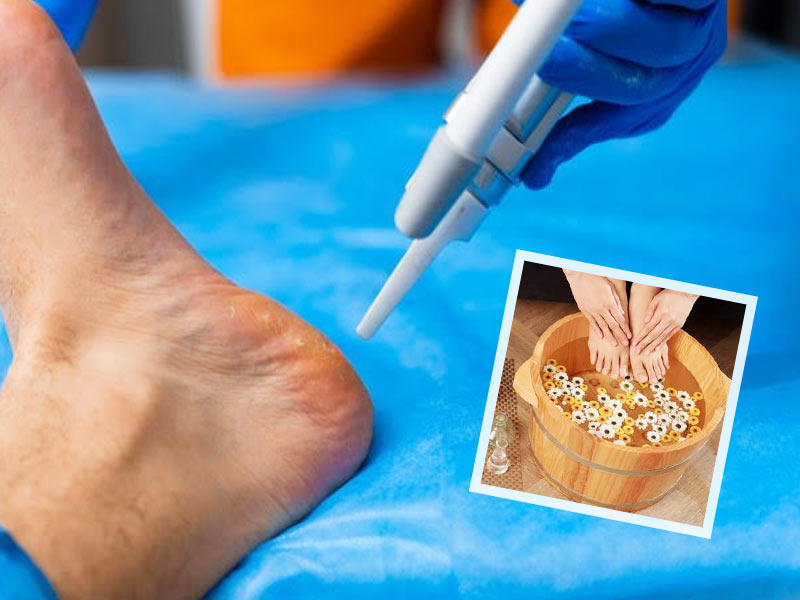
Bacterial infections, fungal infections and common skin problems are mostly seen in diabetic patients. If a person is suffering from diabetes, it is extremely common to have a severe fungal foot infection due to altered immunity due to high blood glucose values and many other factors. According to the Diabetes Association, one out of every five diabetics seeks hospital treatment for foot issues. India being a diabetic capital, we seen millions of patients suffering this problem. Onlymyhealth editorial team spoke to Dr. Rajesh Simon, Foot and Ankle, Trauma and Arthroscopy Surgeon, VPS Lakeshore Hospital and Research Centre,Kochi, Kerala, about the dos and don't care tips for diabetic foot infection.
Table of Content:-
Dos and don'ts for diabetic foot care

If diabetic, don't put off treating a small foot ailment. Foot injuries and infections should be reported as soon as possible. It is important to take care of certain dos and don'ts regarding nutrition, exercise, medicine and doctor's advice. According to Dr. Rajesh, follow these fundamental dos and don'ts to avoid complications in diabetic foot infection:
Dos:
- Perform a daily foot examination
- Stay active to control blood sugar
- Use diabetic shoes and special orthotics if prescribed
- Wash the feet in warm water every day.
- Look for sores, blisters, redness, calluses, or any other concerns on the feet
- Keep them moisturized
- Maintain blood flow to the feet. When sitting, raise your feet, wriggle the toes and move the ankles numerous times a day
- Check the insides of the shoes for any rough seams, foreign objects, etc.
- Have thorough feet examinations yearly
Also read: Diabetic Foot Treatment: Try Diabetic Shoes For Comfort And Health Benefits
Don'ts:
- Numbness should not be overlooked. Untreated nerve injury might cause irreversible harm.
- Calluses, corns, and ingrown toenails should not be home treated. The use of strong chemicals, or bathroom surgery is bad news.
- Crossing the legs or ankles for an extended amount of time might result in undesirable pressure points and skin fractures.
- Heaters, water bottles, and electric blankets should not be used on the feet since they might cause burns
Additional care for diabetic food infection

1. Diabetic footwear
Diabetic foot care necessitates the use of appropriate footwear. Everyday shoes are designed for fashion, but they can also cause pressure spots on the diabetic feet. Patients with peripheral neuropathy are at risk from those shoes that don't fit properly since their feet may not be able to detect whether a shoe is uncomfortable and sore. Diabetic shoes are ideally custom made to remove many of the components in regular shoes that might cause foot harm. A a broad toe box, anti-fungal, minimum or seamless stitching so on are the necessity of a diabetic footwear.
2. Surgery in diabetes
Unlike in the past, the diabetic foot problems especially Charcot foot is now treatable. If adequate multi-disciplinary approach treatment which includes team of foot and ankle surgeon, endocrinologist, vascular surgeon, cardiologist and plastic surgeon is taken then lots of complication can be prevented and limbs saved. Saving a limb is of prime importance giving good quality of life.
Also read: Diabetic Foot Infection: Symptoms, Risk Factors, Treatment And Self Care Tips
What problems can diabetes trigger in the feet?

High blood sugar in diabetic patients wreaks havoc on the nervous system leading to diabetic neuropathy. It can lead to two possible entity creating problem to the feet.
1. Diabetic Neuropathy with Vascular insufficiency
It causes small nerve degeneration in the feet, resulting in loss of protective sensation, numbness, tingling, and pain in the feet. Loss of protective sensation lead to cuts, wounds, and infections without realizations by the patient. Diabetic neuropathy and peripheral arterial disease are two disorders that can occur simultaneously. Alongside the neurological changes the increased blood sugar also clogs the blood circulation.
Clogged blood circulation will lead to plaque formation and these vascular changes lower blood flow to the foot, making healing a wound or infection more difficult. It also possesses the potential to cause gangrene, necessitating amputation, therefore, making it vital to take appropriate care of the feet. Because of loss of protective sensation diabetic neuropathy makes it difficult to detect foot problems in early stages as it is easily overlooked.
2. Diabetic Neuropathy with or without excessive vascularity
The second entity is the combination of changes leading to destruction of the bones of the feet leading to change in shape of the foot and ankle as well as make it unstable making it difficult for patient to even walk. It starts as a innocuous swelling which is often missed and treated as simple cellulitis which leads to this catastrophe called as Charcot foot named after the French Neurologist.
How we keep this article up to date:
We work with experts and keep a close eye on the latest in health and wellness. Whenever there is a new research or helpful information, we update our articles with accurate and useful advice.
Current Version